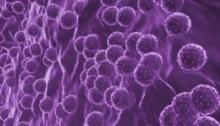BOSTON – Call it interferon 3.0. An investigational form of the immunomodulator, known as interferon-lambda, appeared to be effective against chronic hepatitis C virus infections, but had fewer side effects than interferon alfa, in two separate clinical trials.
In a phase IIb study, ribavirin plus pegylated interferon-lambda-1a (IFN-L/RBV) was comparable in efficacy to ribavirin plus pegylated interferon alfa-2a (PEG-IFN/RBV) in treatment-naive patients with hepatitis C (HCV) genotype 1 or 4 viral infections, Dr. Andrew J. Muir reported at the annual meeting of the American Association for the Study of Liver Diseases.
"The improved tolerability, together with a faster time to virologic response, supports the further assessment of lambda-based, direct-acting antiviral combination regimens in patients chronically infected with HCV genotypes 1 or 4," said Dr. Muir, clinical director of hepatology in the department of medicine at Duke University Medical Center, Durham, N.C.
In a separate small study also presented at the meeting, IFN-L/RBV, combined with a direct-acting antiviral agent, yielded high rates of sustained virologic response (SVR) in Japanese patients with HCV genotype 1b infections, said Dr. Namiki Izumi of Musashino Red Cross Hospital in Tokyo.
IFN-L is a type III interferon with strong antiviral activity but a restricted receptor distribution that is reputed to give the drug a better tolerability profile than the alfa interferons currently in widespread clinical use.
Comparing New and Old IFNs
In the EMERGE phase IIb study, Dr. Muir and his colleagues randomized 527 noncirrhotic, treatment-naive adults with HCV genotypes 1-4 on a 1:1:1:1 basis to either PEG-IFN 180 mcg weekly plus daily ribavirin or IFN-L at dose levels of 120, 180, or 240 mcg weekly plus daily ribavirin. Because of safety issues, patients with genotypes 1 and 4 assigned to receive the 240-mcg dose of IFN-L had their dose reduced to 180 mcg at study week 12, and this dose level was subsequently chosen for phase III trials. Dr. Muir reported results through 72 weeks of follow-up for 407 patients with genotypes 1 or 4 treated for 48 weeks. Approximately 60% of patients in each of the four treatment arms completed treatment and follow-up.
IFN-L at the 180-mcg dose was associated with significantly more rapid virologic responses at week 4 (RVR4 14.7% vs. 5.8%) and complete early virologic responses at week 12 (55.9% vs. 36.9%) than was PEG-IFN (P less than .05 for each comparison). However, there were no significant differences in response rates at either the end of treatment or in SVR24at last follow-up, and relapse rates were similar between the groups.
Adverse events of any grade were similar among the groups, except for lower percentages of myalgia (5.9% for IFN-L vs. 33.0% for PEG-IFN), pyrexia (7.8% vs. 33%, respectively), chills (3.9% vs. 21.4%), and arthralgia (5.9% vs. 20.4%).
Treatment-emergent liver abnormalities included alanine aminotransferase (ALT) 5 to 10 times the upper limit of normal in 2.9% of patients on IFN-L, compared with 4.9% for those on PEG-IFN. In contrast, total bilirubin levels 2.6 to 5 times the upper limit of normal were seen in 5% vs. 3.9%, respectively. In both the 120-mcg and 180-mcg IFN-L groups and the PEG-IFN group, 1% of patients required dose reductions due to liver-related lab abnormalities. In all, 2.9% of patients of IFN-L discontinued the drug for liver abnormalities, compared with 1.9% for PEG-IFN.
High SVR With Lambda and Direct-Acting Antivirals
In the D-LITE study, Dr. Izumi and her colleagues compared IFN-L/RBV in combination with either daclatasvir, an investigational viral NS5A replication complex inhibitor, or asunaprevir, an investigational NS3 protease inhibitor, with each group including a placebo for the alternate direct-acting antiviral agent. (For example, patients receiving IFN-L/RBV and daclatasvir also received an asunaprevir placebo.) In addition, the trial contained a substudy arm with patients assigned to PEG-IFN/RBV with daclatasvir and asunaprevir placebos; Dr. Izumi reported only on the IFN-L arms.
All patients in the IFN-L groups were treated for 24 weeks, at which point those patients who did not have a protocol-defined response (PDR) were given an additional 24 weeks of treatment. A PDR was defined as an HCV RNA level at week 4 below the lower limit of quantification (less than 25 IU/mL) and undetectable HCV RNA at 12 weeks.
In the daclatasvir group, eight of eight patients had a PDR, compared with five of six in the asunaprevir arm. The single patient without a response in the latter arm discontinued therapy for an adverse event at week 3.


